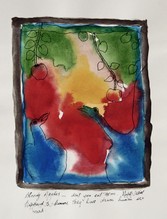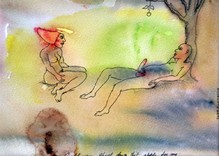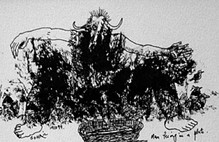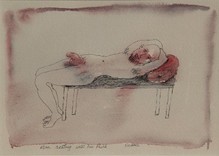
Tasaduq Sohail
Karachi, Pakistan (1930 - 2017)
-
From 23 Mar-2012 To 13 Apr-2012
-
From 29 Oct-2008 To 23 Nov-2008
-
From 21 Jun-2007 To 31 Jul-2007
-
From 11 Mar-2014 To 01 Jul-2014
-
From 10 Jun-2015 To 01 Jul-2015
-
From 05 Nov-2015 To 08 Nov-2015
-
From 01 Dec-2015 To 14 Jan-2016
-
From 31 Jan-2018 To 03 Feb-2018
-
From 21 Mar-2019 To 26 Mar-2019
-
From 01 Apr-2020 To 30 Apr-2020
-
From 01 Sep-2020 To 07 Sep-2020
-
From 20 Jul-2021 To 25 Jul-2021
-
From 22 Feb-2022 To 27 Feb-2022
Selected Solo Exhibitions
Tasaduq Sohail: New Works in the Collection, The Noble Sage, London (2012); Small Oils and Watercolours, The Noble Sage, London (2008); A Painting Retrospective, The Noble Sage, London (2007); The Clifton Art Gallery, Karachi (2007); Zidani Gallery, Karachi (2004); Canvas Art Gallery, Karachi (2003); Exhibition, Croweaters Gallery, Lahore (2003);Mermaid Theatre Gallery, London (1995); Boundary Gallery, London (1993); Greenwich Citizens Gallery, Woolwich (1992); Heritage Gallery, Delhi, India(1991); Lahore Art Gallery, Lahore (1991); Westbourne Gallery, London (1990); Rohtas Gallery, Islamabad (1989); Lahore Art Gallery, Lahore (1989); Nairang Gallery, Lahore (1989); The Playhouse, Nottingham (1988); Horizon Gallery, London (1987); Alhmera, Lahore (1986); Rohtas Gallery, Islamabad(1986); Nairang Gallery, Lahore (1985); The October Gallery, London (1979); Indus Gallery, Karachi (near annual exhibition) (1977-2002); Hathorndon Gallery, UK† (1976)
†
Selected Collections
Arts Council, London; Victoria & Albert Museum, London; Arts Council, Pakistan Numerous other collections in Sweden, Norway, India and the UK
†
Selected Bibliography & Other Media
T. SOHAIL: Death and Regeneration by E. Alkazi
†
Bandung File, TV Programme, Channel 4, 1987; BBC TV Programme, 1979; Zee TV Programme, 1995 & 1996; Richard Cook Interview, Channel 4Interview, BBC London radio; BBC Radio, India; BBC Radio, Pakistan; Radio Nottingham, UK
Rebellious, unaccommodating and prolific, Tasaduq Sohail is today certainly one of the most renowned contemporary artists of Pakistan. Now 77 years old, Sohail is still as busy as ever; still holding regular exhibitions and still going to great lengths to have his art travel to all corners of the world for exhibition. He has had more than 40 solo exhibitions to date, more than 25 in Pakistan (particularly at the Indus Gallery in Karachi where he had his first exhibition in 1977) and 15 internationally in addition to the UK, Sohail has an especially large following in Scandinavia. In auctions he has been equally successful, his buyers flocking to collect his idiosyncratic oeuvre. Sohail, to his glee, is finally enjoying the success he so rightly deserves after more than forty years of toil to make his mark on the London art scene. The cost of this happiness has been immense: a psychologically-scarring youth in a corrupt country warring for its independence and subsequent self-exile from his family at the age of 31. To this day, Sohails work is very much the product of these early formative years in Pakistan.
†
Sohail was born in Jullundhar in East Punjab in 1930. It was a time of great change for the country. With partition in the midst of taking effect in 1947, his home region was soon in bloody turmoil with many different groups vying for domination. Sohail remembers how it all radically changed: I was in 8th and 9th class at school it was a very mixed society in Jullundhar Hindus, Sikhs, Muslims lived in harmony. [Then] this was no more. There was murder everywhere. The whole country seemed in utter chaos to the young Sohail. The gory images that he saw first hand will never move from his memory. People were lying on the roadside, killed Arms and legs. And so many vultures and crows hovering to eat the flesh. Sohail remembers their fleeing Jullundhar for Lahore during the rioting: They nearly killed me in Amritsar we could see them sharpening their knives. They were going to kill the whole train. It was only incidental luck that his family escaped with their life: a bloody knife not cleaning down as fast as it should, a call from a senior commander distracting the killers from their task. He remembers the terrible fate of so many of his family friends. Sohail knows that itis only blind luck that he has lived to tell the tale.
†
Haunted by this bloodshed, Sohail and his family were forced to start again. His father, a poor clerk, in Sohails words, worked like a bullock and produced innumerable children to satisfy his lust. Dissatisfaction and tragic inevitability became a defining element of the artists early life. He became frustrated by the stasis of his familys poverty-stricken life and the ineffective and corruptive workings of a civil service that disabled his family and friends, tying them to the ball-and-chain of a meagre family allowance. It is in these early years that a key hatred began to take shape in Sohail a strong loathing of those systematic forces that contained and suppressed humanity and its natural longings. The mullahs walking amongst them, preaching God and their understanding of a correct way of life, became archetypes of oppression and abuse. These figures of supposed piety were the great enemies of Sohail insidiously guiding violence and destruction from behind-the-scenes. They were the greatest of hypocrites: These mullahs say they do not want for sex on earth but in reality they want it in heaven. In heaven women walk around in the nude [ready for sex]. They want it after their life on earth, after death. But after death there is nothing. You are dead! Sohail began to see all religions as the same repressive system, antithetical to the very act of living and enjoying the life that one is given. Whether it is priests, rabbis, or mullahs, to Sohail they were all living a lie and, worst of all, forcing others to live the same way.
†
Seeing his constrained life before him as a regurgitation of that of his father, and prompted by an arranged marriage he did not desire, Sohail left for Karachi. He didnt proceed further than the third year of his degree before he was distracted by his first artistic endeavour, not in art but in the field of literature. He became a student of writer and translator, Mohammad Hassan Askari, and under the inspiration of this mentor, Sohail wrote short stories in Urdu. It was his first successful artistic route and one that would come to play an important role in his art. Writing (and reading widely) gave Sohail much happiness during this period. The work of Balzac became a constant resource for the artists imagination and creativity. However, as much as these printed words on the page engaged him, the longer he stayed in Pakistan the more oppressive the nation seemed to the young artist; the distance between him and those forces (his father included) that aimed to suppress him and his natural existence was forever closing in on him. By 1961,this claustrophobia became too much and the artist left Karachi for England with the intention of never returning. It was the end of a life that was never life as he had imagined it. London offered the promise of release and it is indeed this freedom that he longed for.
†
London life was harder than he had expected. He lived a lowly, often penniless existence in North London. Between 1961 and 1965,he took up forty-five jobs: a bus conductor, a waiter and a shelf-filler at a supermarket to name just a few. All were menial positions. It was a rite of passage for Sohail. To be fully free from the atrocities seen during his youth, the oppressive social rigour of Pakistan and the forceful hand of his father, Sohail had to survive at the bottom of existence with nothing to his name except his humanity, individuality and freedom. All human pride was put aside as he moved from one job to the next trying to make ends meet. Sohail laughs about it now but being turned away from the job of toilet cleaning, an occupation that in his homeland would have been seen as the lowest of all jobs, would certainly have cleaned him of any glimmer of self-worth or any last vestige of the social hierarchy of Pakistan. Though hard times, Sohail never ignores these first years in London. They were crucial to the exorcism of his demons.
†
The story of how Sohail fell into art is a comical one and one that the artist defiantly never hides from his interviewers. His early years in London were hard most of all because of the loneliness. In Karachi, his surname would carry weight and women would always be enticed by the young Sohail. He would therefore rarely be without. In London this was not the case. This for Sohail (a man who in his old age has been known to sport a ponytail to cheekily rally attention from the opposite sex) was difficult to take. He yearned for a girlfriend so much so that on a bus journey, surrounded by a group of attractive young women, the artist asked one of them where they were all going. He found out that they were taking an evening class at Central St. Martins Art College. It was a nude drawing class and Sohail was therefore, for many reasons, enticed by this idea. As the artist states, the strip joints he was visiting were leaving him utterly broke and so this was cheaper. In his first lesson at Central St. Martins, the artist remembers sweating furiously at the prospect of drawing the nude in front of him. He remembers all the other students creating beautiful drawings, like photographs. His own effort he recalls as a mummified, lost in fog thing, no line, no form, just mess. I thought they were going to kick me out. But the teacher saw genius in this first artistic attempt and rather than teaching him to draw correctly, he was instead encouraged to push forward his original style. It was an unlikely start of a career in art but one which Sohail remembers with fondness. No doubt, art enhanced the freedom he already felt in London and immediately appeared a means to approach the past from which he was hiding.
†
Whilst continuing on the brink of poverty, subsisting on further menial jobs as well as selling works from a stall in Bayswater, Sohail now obsessively churned out small works of art in every spare moment that he could find. Rising at 5am, he would paint until 10am.This ended he would normally leave for Burger King or McDonalds in Golders Green, anywhere you dont get bothered and there are lots of people around. He would draw for a further four hours. The works created were generally small in size mainly due to his lack of money though also because this format best suited his developing style. Inspired by artists like Max Ernst, the artist used a decalcomania technique, allowing blots of dilute ink created after pressing a piece of glass on the paper to suggest the image ahead. The final result in pen and ink was a concentrated, spidery persistence of line erupting from darkness often describing the fetid underside of the buoyant life he saw around him in McDonalds. Sohail uncovered in his drawings a life born of death and decay; his work told of death in life. Through the heavy veil of his own anxieties and the violent experiences he had witnessed as a youth, his art combined natural landscapes with charnel house-like goriness. Smiling skulls and bloody carcasses would amass and intermingle with heaped rocky vegetation and the debris of pillars, symbols of civilisation. Whenever pen was put to paper, a new killing field would emerge from beneath it. Below each work, Sohail would sign his name, the date and place of execution, the temperature and his own blood pressure as if the very act of creating the work had an effect on his heart rate and, likewise, as if the location of his execution was the direct inspiration for the gruesome image.
†
In many pieces mullahs or miscellaneous priests are caught with their pants down in compromising situations. Their hypocrisy was the target for Sohail, their sordid dream/real life activities a point of indignation and satirical ridicule. Animals likewise would feature highly in Sohails work. No doubt drawing on his early literary studies, Sohail took inspiration from Persian poetry, particularly the poetry of Sheikh Saadi, a rich repository of Hikayat fables, narratives and parables. Here birds and animals somehow possess the faculty of the human mind and are the carriers of advice for man. Untouched by the degradation of humankind and the deterioration of human values, Sohails animals become the standard-bearers of natural order. They often are witness to the depravities of human sexual lust, their naÔve existence being the proof of another idyllic way of living. For Sohail, a great pet lover, animals were symbolic of all that was right in a world that was out of joint: Animals, I love mostly and human beings, I hate mostly. In his oeuvre, animals replace the corrupt mullahs and priests as the epitome of God and godliness. As Sohail puts it, There is a God. The whole of nature is God.
†
A wry sense of macabre humour is clearly evident in much of Sohails work. His work reminds us of artists such as Honorť Daumier, Hieronymus Bosch and George Grosz. The world to Sohail is so dehumanised and immoral that laughter has become a necessity just to bear its tragedy and abhorrent nature. Men are disgusting puppets that he loves to hate so much as to wish them off the face of the earth. There is a strong understanding in his work, however, that he is not perfect himself; that he has no right to preach either. Many works, he will freely admit, are enunciations of his own lust as much as that of mankinds. On the one hand Sohail is pushing for sexual freedom and on the other he is asking for sexual temperance in relation to nature and natural order. One must have sex as animals do, with passion, freely and uninhibited, though we should do so within a framework of the laws of nature. His works are therefore bacchanalian celebrations as well as preventative descriptions of where we might end if we do not listen to ourselves internally.
†
Balanced with this dark wit, is an almost naÔve, simplistic idealisation of the world in his canvas painting that evokes the work of artists like Marc Chagall and Claude Poussin. When landscapes or situations are made pretty by Sohail, however, it is often to the point of our disbelief. Animals frolic and trees and meadows flourish under a strange unnatural sunlight. Though Chagall sets us at ease with his colour and Poussin does the same through his compositional structure, Sohail doesnt leave us with the same sense of contentedness. As the artist himself admits, he sugar-coats bitter truths in many of his pictures. The images he creates of harmonious life are artistic red-herrings; they are infested carrots dangled in front of our donkey faces. They are the encapsulation of our denial and the illusory imagery we conjure up to convince ourselves that life is not a slow decline toward death. It is, for all sense and purposes, a mirage, a perfect memento mori describing the transience of life and mutability of matter. In this way, even in his beautification of the world, Sohail is cutting to the core.
†
At heart, Sohail is an artist who is very much the product of his past. The work that he is most known for, the work that is in this exhibition, will always remain at the fore of our minds because of its distinctive sensibility of vision of the human condition as well as the condition of the artist himself. His understanding of nature and our positioning in nature is thoroughly personal and speaks of a man trying to find the correct way amidst his own longings and needs, societys oppressive rulings, religions heavy dogma and his familys traditions. He is the classic immigrant trying to appease the ideal values and experiences of his native land with those of his new home. Where do we stand with so much violence and suffering in the world? Where is there to turn to? Sohail asks in his work. A definitive answer is not given but the direction of nature is always a constant salvation. Somewhere along the way, humanity became corrupt and misled; it became lust-driven, violent, abusive and greedy. Sohails work tells us to look inwards for the right way to behave; not to priests and other religious authorities but to that that is nature within all of us. This is indeed all the guidance we need.












